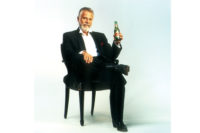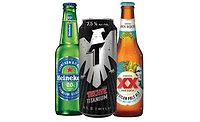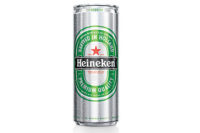HEINEKEN USA accelerates growth through product, packaging and marketing innovations
Heineken USA rolls out new products, packaging, marketing.




Amstel Light was trademarked as “The Official Beer of the Burger” and will partner with events in key markets to entice millennials of legal drinking age to begin pairing their burgers with the beer. (Image courtesy of HEINEKEN USA)

For the first time in four years, Newcastle is back in the black thanks to the success of its seasonal releases and “No Bollocks” advertising campaign, says Charles van Es, brand director for Newcastle. (Image courtesy of HEINEKEN USA)

HEINEKEN USA officially added Strongbow to its portfolio in January, and in the first 36 days, it secured more than 10,000 points of distribution, says Lesya Lysyj, senior vice president and chief marketing officer. (Image courtesy of HEINEKEN USA)






Among the pumping bass, neon lighting and professional dancers at this year’s nightclub-themed National Distributors Conference for HEINEKEN USA, White Plains, N.Y., a subsidiary of Amsterdam-based Heineken International B.V., the company announced that, for the first time in five years, Heineken Lager is back in the black. Mirroring its goal for 2013 — accelerate — HEINEKEN USA has reclaimed growth for its flagship brand in 32 states and hopes to hit all 50 states by the end of the year, says Scott Blazek, senior vice president of sales.
The previous year’s goal was growth, he notes, and as a result, in 2012 total company performance increased 4.4 percent; Dos Equis was up 26 percent; and Tecate Light was up 28 percent, Blazek says. In the on-premise segment, focusing on the company’s strategic better beer accounts, Newcastle was up 3 percent; Heineken was up 14 percent; and Dos Equis was up 33 percent. In 2013, the company aims to increase its distribution base by 10 percent, with a 50 percent growth target for key 2013 brands, Dos Equis and Strongbow.
Although the beer category has been struggling to regain share from wine and spirits, upscale import beers were up more than 3 percent in volume in 2012, notes Dolf van den Brink, president and chief executive officer.
“After years of losing share in total alcoholic beverages, we’re starting to close the growth gap,” he says. And according to van den Brink, this is only the beginning.
A diversified portfolio
The beer category is faced with three major challenges: sameness, SKU proliferation and diminished import support, van den Brink says. Currently, four mainstream beer brands account for approximately 80 percent of the beer market, he explains.
“If our vision is for total beer to grow share in total alcoholic beverages, mainstream needs to grow as well,” van den Brink says. “It’s such a significant portion of total beer, and in order to maintain or grow regional support, we need to grow the total size of the category.”
Therefore, it is critical to add variety and choice to the mainstream segment, he says. HEINEKEN USA’s Tecate and Tecate Light brands, for instance, are aimed at mainstream Hispanic consumers and provide variety, he adds.
On the other hand, increased SKU proliferation can lead to consumer confusion. According to van den Brink, beer SKUs have expanded an average of 12 percent each year since 2006, and last year they accelerated to 15 percent. This means that almost 60 percent of the SKUs in beer aisles did not exist five years ago, he explains. As a result, the beer category must find balance between variety and efficiency, he says.
Import beers are growing toward 15 percent of total category volume, van den Brink adds. However, total import SKUs are growing slower than the industry average. Last year, import SKUs actually declined, yet imports generated more than 8 million cases of incremental growth in the same period, demonstrating the segment’s efficiency, he says. The increasing population of Hispanics and Asians in the United States also will lead to further import growth, he notes. However, import beers are still losing shelf space to craft beers, requiring improved execution support, he says.
In response to these industry challenges, HEINEKEN USA is poised to “accelerate” its brands in 2013 via a diverse portfolio, creative advertising and packaging innovations.
“Our approach is to grow a small number of big ideas step by step, grounded in consumer insights,” van den Brink says.
‘Star’ packaging
HEINEKEN USA’s premium import brand, Heineken, is and always will be its No. 1 priority; however, its brands aimed at the Hispanic market and its Strongbow hard cider also are important priorities, van den Brink says. In fact, the company’s Beers of Mexico variety 12-pack, which contains Dos Equis, Tecate and Sol beers, was the No. 1 import innovation last year, Blazek says. The company is looking to achieve 38 percent growth this year, going from 1.6 million to 2.2 million cases in 2013, says Matt Kahn, vice president of marketing for portfolio brands.
Building on the success of the Beers of Mexico 12-pack, HEINEKEN USA introduced a new packaging format for the variety pack this month. The Beers of Mexico cooler pack enables consumers to expand the paperboard upward and pour ice directly into the box, which can hold ice for up to eight hours, according to a brand representative.
The company’s No. 2 priority, Dos Equis, plans to launch a new packaging innovation next month, too. New 7-ounce glass bottles initially will be available in Texas, but distribution will expand once it has gained recognizable success, Kahn says.
Outside of its Hispanic portfolio, HEINEKEN USA launched its Newcastle Brown Ale in 10-packs of 14.9-ounce cans, line priced with the 12-pack bottles so the two packs can be promoted together. According to New York-based market research firm Nielsen, cans made up 58.1 percent of the total beer market during the 52 weeks ending Aug. 11, 2012, in U.S. food, convenience and drug stores. The Newcastle can will create more use occasions for the beer, the company says.
But above all, the Heineken brand’s new packaging innovation is the “star” of the segment. This month, the brand rolled out Star bottles nationally to streamline the appearance of the Heineken and Heineken Light bottles. Available in 12- and 22-ounce sizes with a taller, thinner shape, the Star bottle features an embossed thumb groove that improves grip and encourages consumers to hold the bottle at a lower point, keeping the beer colder, the company explains.
“Launching the Star bottle is a once-in-a-lifetime opportunity to bring a whole new energy to the Heineken brand and gives us a tangible signal that Heineken is back,” says Lesya Lysyj, senior vice president and chief marketing officer.
The bottle initially launched in the on-premise segment in New York City in September. As a result of the launch, the brand grew 4.5 percentage points during the fourth quarter, says Colin Westcott-Pitt, vice president of marketing. Prior to the launch, the Heineken brand was down 3 percent; after the Star bottle launch, the brand was up 1.5 percent, he explains. Furthermore, consumers’ purchase intent changed as a result of the packaging. Before the Star bottle was released, 23 percent of consumers said Heineken would be their first choice, he says. After the Star bottle launched, the number rose to 34 percent. Likewise, before the Star bottle launched, 15 percent of consumers said they would be loyal Heineken drinkers. After the Star bottle was released, the number bumped up to
20 percent, he adds.
Between March and July, a new TV spot will combine the company’s Legends campaign with a story that focuses on one man’s quest for the Star bottle. Out-of-home ads also will announce the new bottle with phrases like, “Presenting the Star bottle,” “127-year-old beer in a 0-year-old bottle,” and “New Heineken bottles now arriving nightly,” he notes.
“It’s not just a new bottle; it’s a complete redefinition of how consumers see us,” Westcott-Pitt says. “It’s not just Heineken Lager; it’s Heineken Light as well — the brand acting like a true family. And it’s not just another ad campaign or marketing program; it’s going to be seen and touched by everybody who buys Heineken.”
‘The Cider House Rules’
In the past, beer was a loyalty category; however, it is quickly becoming a repertoire category, Lysyj says. Therefore, a diverse portfolio of brands can be important to reach a wide variety of consumers. HEINEKEN USA’s portfolio of premium, Mexican and mainstream beers reaches a variety of consumers. Plus, its entry into the hard cider market expands the company’s demographic reach even further. According to Lysyj, the hard cider category grew 100 percent in 2012.
“This category is poised for the kind of growth that I don’t think we can even imagine right now,” Lysyj says. “It brings in a new consumer and is a rare opportunity for all of us to expand our collective footprint.”
Hard cider appeals to urban millennial consumers and is split 50/50 between men and women, Lysyj says. Consumers enjoy these drinks because they are less filling, sweeter and seen as a more natural alternative to beer, she adds. The company officially added Strongbow to its portfolio in January, and in the first 36 days, it secured more than 10,000 points of distribution, she says. According to the company, Strongbow is its No. 3 priority after Heineken and Dos Equis.
HEINEKEN USA will launch Strongbow into an upscale, aspirational badge brand, one which consumers will want to be seen drinking, the company says. In order to accomplish this goal, the company’s No. 1 focus for Strongbow is in the on-premise market, Lysyj says. And in the off-premise, the company hopes to double Strongbow’s distribution, Blazek adds.
Niche demographics
Although the Strongbow brand is unique in the number of female consumers that it reaches, the rest of HEINEKEN USA’s brands also target unique demographics throughout the United States.
Generally, HEINEKEN USA’s brands target urban consumers between legal drinking age and 31, and luckily, the urbanization rate is increasing around the world, says Jean-Francois van Boxmeer, chairman of the executive board and chief executive officer of Heineken N.V. Fifty percent of the world population today lives in cities, he says. That number will likely increase to 70 percent within 10 to 20 years, he adds.
Like Heineken Lager, Heineken Light appeals to urban consumers; however, its target demographic is changing slightly. To help boost sales of Heineken Light, the company is repositioning the brand and targeting today’s urban achievers, Westcott-Pitt says. These consumers are the leaders of trends who value progress and achievement, he says. HEINEKEN USA will increase its media investment in Heineken Light by more than 50 per-cent in 2013. To reach its new consumer segment, the company developed an advertising campaign that champions the new Star bottle and uses art for modernity and progressiveness, he explains.
“It champions the new bottle but at the same time uses contemporary artists to deliver a unique art design that will be picked up in social networks as well as the physical environments where we place it,” Westcott-Pitt says. “Very modern; very progressive.”
Heineken’s Mexican beer portfolio, however, reaches a different group of consumers — and each brand has its own unique positioning.
Tecate and Tecate Light beers are aimed at the mainstream male Hispanic consumer and focus on representing the masculinity or “hombre” of men,
says Felix Palau, vice president of marketing for the Tecate and Indio brands. The Tecate brand increased 17 percent during 2012, and the Tecate Light brand grew 50 percent during the fourth quarter of 2012, he notes. In 2013, the company plans to increase the percentage of its Tecate marketing budget for Tecate Light from 10 to 50 percent, he says. Both beers are particularly popular in southwestern U.S. markets like Arizona, Texas and Southern California, he adds. In the second half of 2012, the company launched Tecate Michelada, which combines Tecate beer with lime and Mexican spices, in select markets.
Last summer, HEINEKEN USA brought Indio to select markets in the United States. This beer brand is aimed at Latino millennials, or “Los Indies,” of legal drinking age, who represent 25 percent of the U.S. youth, says Raul Esquer, Indio brand manager. These consumers prefer to discover brands for themselves and are drawn to brands that express their identities by creatively fusing urban and Latino cultures, the company notes.
“Market segmentation continues to have a major impact on the industry, and Indio will use this trend to create a very specific campaign that speaks directly to the niche audiences’ interests and passions in life,” Palau said in a statement.
This year, HEINEKEN USA will develop Casa Indio, which transforms an existing local space into a music venue on the weekends and a place for events like private dinners and art shows for consumers, retailers, media and others during the week, Esquer explains. When visiting Casa Indio, consumers can use social media to broadcast their experiences, therefore creating impressions for the brand and enabling other consumers to “discover” it via word-of-mouth, Esquer says.
Marketing madness
Outside of marketing to niche demographics, HEINEKEN USA also is increasing its marketing efforts across the board to improve its sales. The company’s Dos Equis brand has been particularly successful, experiencing double-digit growth year after year, Kahn says. In fact, in 2012 it increased 20 percent, which is the highest increase in Dos Equis history, he adds. The brand also will continue its successful “Most Interesting Man in the World” campaign for the seventh consecutive year with new TV and digital spots, the company notes. Nevertheless, where Dos Equis has excelled, other brands in the portfolio have struggled.
Amstel Light, for instance, has struggled in recent years; however, the company has developed a strategy to bring it back to life, Kahn says. Not including veggie burgers, each year 14 billion hamburgers are consumed in the United States, he says. To complement this food, Amstel Light has been trademarked “The Official Beer of the Burger” and will partner with events in the brand’s core markets — New York, Chicago, Boston and Philadelphia — to entice millennials of legal drinking age to pair their burgers with Amstel Light. Amstel Wheat also will benefit from these partnerships as well as consumers’ growing interest in wheat beers, he adds.
The company’s Newcastle Brown Ale brand also is rebounding. For the first time in four years, it is back in the black, says Charles van Es, brand director for Newcastle. The brand portfolio was up 6 percent in 2012 and continues to see success with its seasonal launches as well as its humorously honest “No Bollocks” advertising campaign, which kicked off last year and will appear on national TV this year, he notes. This May, the company will release its new summer seasonal, Newcastle Bombshell, which is a blonde ale. For the first time ever, the company also will launch TV commercials to support its limited-edition releases, he says. Additionally, Newcastle is focusing on the brand’s tap handles, which have sparked consumer interest. Its limited-edition Newcastle Werewolf tap handle, for instance, made numerous social media impressions and even ended up on eBay for six times its worth, he says.
Although the Dos Equis Ambar brand increased 4 percent in 2012, the company plans to grow it further by sampling the product on-premise more than ever before and using social media to increase page views and grow brand awareness, Kahn says. For example, this year the company will launch a Facebook promotion letting fans select a new “Most Interesting Man in the World” TV commercial.
Overall, the company plans to continue building on the growth of all of its brands, delivering identity, status and an emotional tie to its consumers.
“We take pride in building badge brands, and that’s why we believe that the choice between craft brands and mega brands is a false choice,” van den Brink says.
“We believe there’s another way: a space between the extremes of sameness and confusion; a place for meaningful entertainment, meaningful experiences, stories that ring true, emotion. And behind all of that, there’s something even more; something special; something nobody else has. We bring a smile to beer. We bring a little bit of magic.”
Looking for a reprint of this article?
From high-res PDFs to custom plaques, order your copy today!












